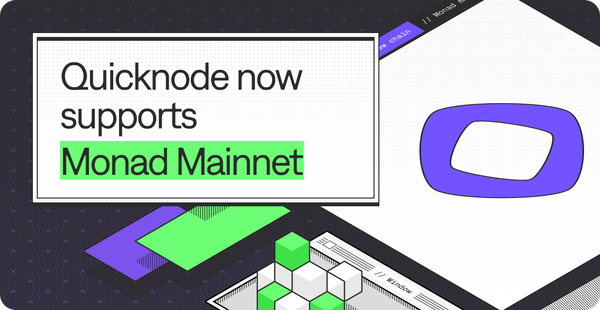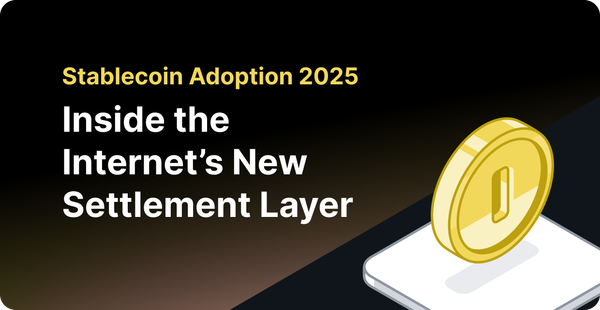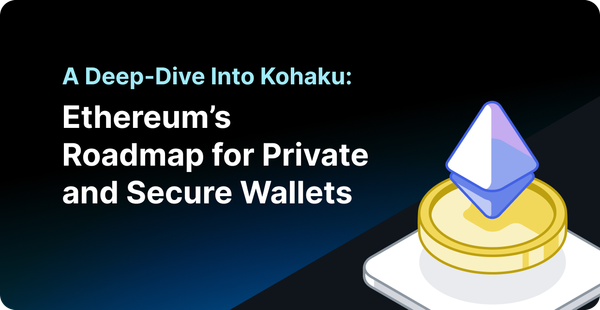x402 Protocol Explained: Inside the HTTP's Native Payment Layer
A deep dive into x402: the HTTP-based payment standard that lets APIs and apps charge, verify, and settle natively on the web.

Web, natively, has had the ability to move anything of value. HTTP moves information, SMTP moves mail, TCP moves packets of internet data. But nothing natively moves money.
To be fair, the internet’s early architects did leave a backdoor for it — HTTP 402: Payment Required — but it never did move money.
Maybe, the code was waiting for technology to catch up with its vision? There's no definite answer to that, but today, we have an update.
Coinbase has recently reactivated this long-forgotten capability through the x402 protocol — a native vehicle to move money at scale on the web.
In this blog, we’ll see what the x402 is, how it works, the is possibilities the protocol unlocks, what it means for builders, and where the risks are.
First of all, what exactly is x402?
What is x402 Payments Protocol?
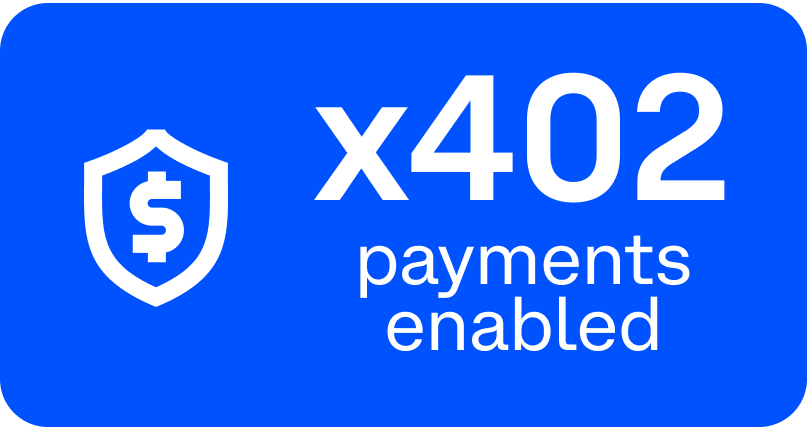
x402 is an open payment standard that enables any website, app, or API to request and collect payment before delivering content or services.
All of this underscores the importance of x402 being directly accessible through HTTP requests, meaning no extra payment gateway, checkout pages, or API keys will be required.
Imagine Vitalik Buterin writes a newsletter on Substack and serves it behind an x402-enabled paywall.
Every click on the ‘read’ button triggers a 402 response and prompts a payment. Once the payment is done and verified, the full content is delivered.
Both flows (dollars-out and content-in) occur through HTTP itself with no checkout or redirects. And more importantly, the transition is verifiable onchain.
This creates an internet where payments happen as naturally as loading a webpage.
Understanding why traditional payment systems fall short for modern applications underscores the importance of x402.
Why Web2 Payments Don't Work for Web3 and AI Agents
The traditional way of money moving online always assumes a human is in the loop of typing card numbers, confirming OTPs, waiting days for settlements.
Money, identity, and its interplay have evolved a lot ahead and away from this assumption.
- APIs now talk to each other.
- AI agents act on their own.
- Smart contracts finalize transactions in seconds.
In short, the internet has become programmable, but payments haven’t.
Let’s understand what this means in the real world.
Identity and Authentication Architecture Needs an Overhaul
Web2 payments demand account creation, passwords, and KYC processes. Why?
Traditional payment systems are built around accounts, not requests.
They assume a fixed identity: a human with a wallet, login, and manual approval.
Modern applications — decentralized protocols, AI agents, and autonomous APIs — need stateless and programmatic payments processed automatically in milliseconds.
Legacy Financial Infra is Full of Intermediaries
Each traditional payment comes with a chain of intermediaries — card networks, acquirers, gateways, universally accepted currency, such as USDC, requiring fees attached.
Charging $0.01 for an API call or per-minute access isn’t viable when the payment processor takes $0.30 and settles in T+2 days.
In contrast, stablecoin-based flows can settle globally, near-instantly, and atomically, which is ideal for pay-per-use or agent-driven activity.
Fragmented Global Access
Money online still routes through national banking systems, not the internet itself.
APIs or services that aim for a global user base must integrate with multiple providers, compliance regimes, and payout systems.
Web3-native settlement (like x402) works with a single, digital, and universally accepted currency, such as USDC, requiring no separate integrations or licenses.
Now layer AI into this.
AI Agents Cannot Access Money
AI agents can call APIs, process data, and act autonomously but they can’t pay money.
They lack access to banking APIs, card credentials, or KYCed accounts. Without a native way to handle value, most agentic systems hit an economic dead end.
x402 gives these systems a universal payment interface, bridging compute and commerce.
In essence, x402 tilts the power dynamics towards users in addressing systemic concerns, such as account vs. request, trust vs. verification, and delay vs. finality. The end result is the web finally getting its own way to move money. Next, let’s see how x402 actually works.
How x402 Actually Works: A Simple Breakdown
The x402 flow extends a normal HTTP request–response cycle with one new step: a payment handshake that’s cryptographically verifiable onchain.
Everything still happens within HTTP; the blockchain simply runs in the background through a facilitator.
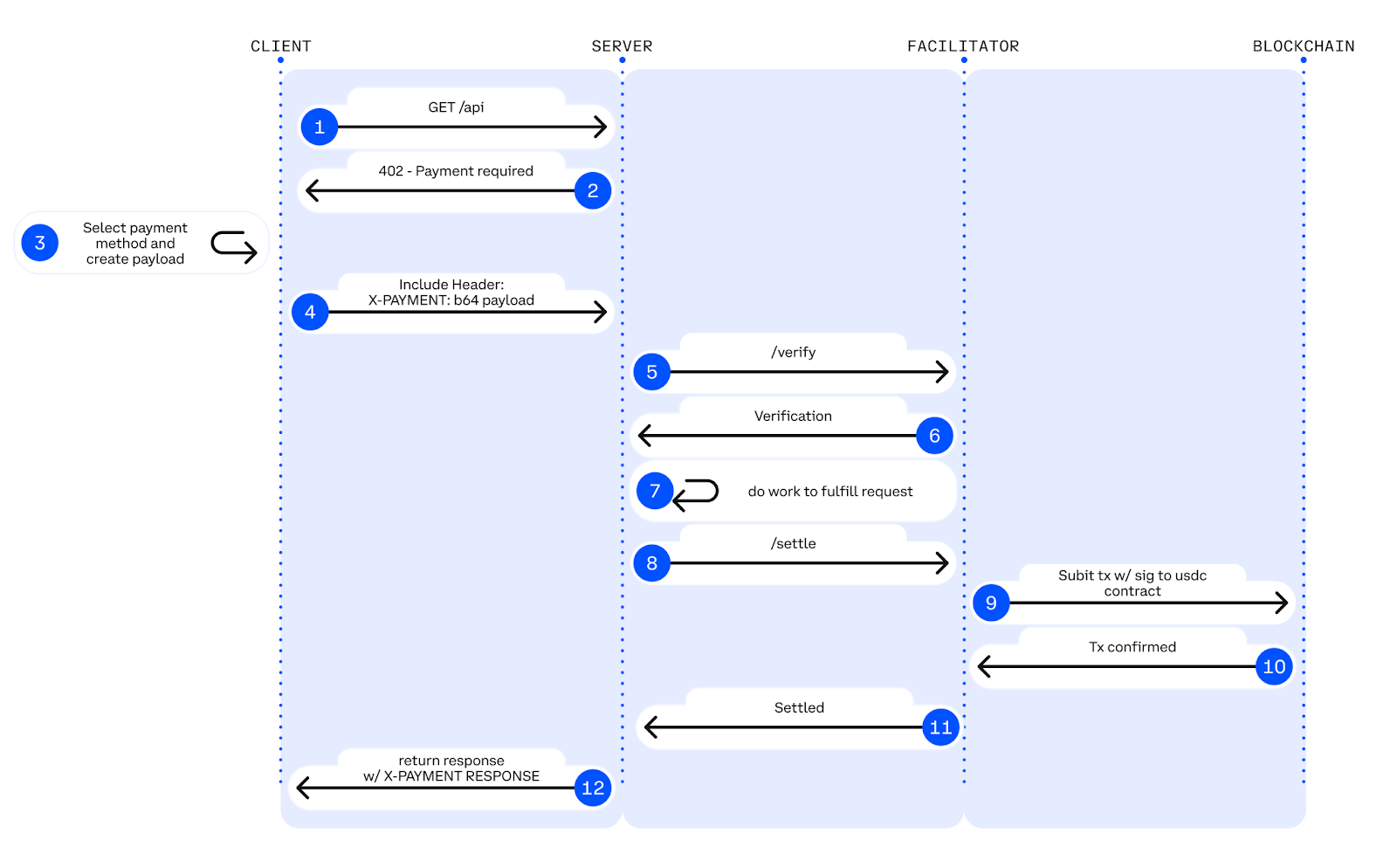
Phase 1: Request → Quote
- The client requests a resource (for example, GET /api).
- The server replies with HTTP 402: Payment Required, including a JSON payload that specifies:
- Price (ex: 0.05 USDC)
- Supported network (ex: Base Mainnet)
- Facilitator endpoint for verification
At this point, the client knows exactly what to pay and where.
Phase 2: Pay → Verify
- The client generates a signed payment payload and retries the request with the same payload, adding an X-PAYMENT header.
- The server forwards this payload to the facilitator’s /verify endpoint.
- The facilitator verifies the signature and confirms that the payment parameters are valid.
No wallets, redirects, or external checkout flows here.
Phase 3: Settle → Deliver
- Once verified, the server executes the request (for instance, computing or fetching the resource).
- The facilitator settles the transaction onchain, submitting the signed transfer to the stablecoin contract.
- After confirmation, the server returns HTTP 200 OK with the requested content and an X-PAYMENT-RESPONSE header referencing the transaction hash.
Payment and content delivery become part of the same HTTP loop.
In essence, x402 condenses the entire payment lifecycle — pricing, verification, settlement, and delivery — into a single HTTP conversation.
Next, let’s explore what becomes possible once the web itself can quote and collect payments in real time.
What Becomes Possible With x402 Protocol
That subtle shift — embedding payments into HTTP — standardizes how value can move across the existing web stack.
Additionally, this represents an exciting intersection of traditional internet infrastructure, eliminating the need for web3 or cryptocurrencies, in general.
Here are some practical capabilities x402 can enable:
- Pay-per-call: APIs can charge per request—pricing, payment, and data delivery in one HTTP loop.
- Metered compute: AI inference, GPU time, or storage billed per use and settled automatically onchain.
- Agent payments: AI agents can pay other agents or APIs directly, eliminating the need for manual triggers or keys.
- Dynamic pricing: Servers can adjust resource costs in real time and quote updated prices via 402 responses.
- Usage-based APIs: Endpoints expose exact pricing for each call, allowing services to operate as micro-economies.
These examples are general and may not provide an immediate pictureAdditionally, this represents an exciting intersection of traditional internet infrastructure.
So, let’s make it real.
- Imagine Messari’s premium crypto reports being atomically available for purchase.
An analyst bot can fetch a single report, pay in USDC, and receive access instantly, all within a single an immediate picture verified HTTP call.
- Or consider Chainlink’s data feeds, where each request dynamically prices itself based on network congestion or source demand instead of rigid tiers.
- Or take Dune: every data query or dashboard export could be a verifiable transaction, paid once, delivered instantly, auditable onchain.
These scenarios may seem speculative today, can fetch a single report, pay in USDC, and receive access instantly, all within a single but they’re structurally possible today because x402 bridges two existing primitives: HTTP for delivery and stablecoins for settlement.
The next question, then, is what this means strategically for developers, platforms, and the wider web.
Strategic Implications of x402 Implementation
x402’s significance isn’t just technical;, it’s also architectural and economic. By embedding payments inside HTTP, it quietly reshapes who controls monetization, how value flows between machines, and what infrastructure companies need to provide.
Developers regain pricing control
For the first time, pricing becomes a protocol-level primitive.
Instead of relying on platforms or payment providers, developers can set and enforce pricing directly from their endpoints.
APIs become self-sustaining
An API that earns per call can fund its own maintenance without SaaS overhead or subscription fatigue.
This changes how open APIs are built, from cost centers to micro-revenue engines.
Infrastructure turns transactional
CDNs, RPC endpoints, and compute networks can be billed by actual usage in real-time.
x402 creates the economic bridge between bandwidth, compute, and blockchain settlement.
AI Agents gain access to money
AI agents can now pay for services — including inference, APIs, or data access — without relying on being billed by actual usage in real-time, centralized wallets.
That makes agent coordination and service marketplaces economically viable.
Stablecoins find a native internet rail
USDC and similar assets evolve from exchange tools to web primitives.
They move through HTTP, positioning stablecoins as the settlement layer of the programmable web.
The above strategic implications paint a real picture of what x402 will look like in the coming days.
However, the most important consideration is whether it solves actual customer problems more effectively than alternatives.
The next section examines some of the hidden challenges with x402 that require careful attention.
Hidden Challenges with x402 That Need Answers
If all the above points have shouted this already, here’s the summary: x402 is elegant in concept and pragmatic in design. But elegance doesn’t guarantee adoption.
For the web to actually move money through HTTP, several architectural, economic, and behavioral questions still need to be solved.
Token Compatibility Limitations
The protocol fundamentally relies on EIP-3009 ("Transfer With Authorization"), a standard proposed by Circle in 2020 but not yet widely implemented. Currently, only USDC supports this standard natively, severely limiting token choice despite claims of token-agnosticism.
Other stablecoins or tokens require custom facilitator implementations or workarounds, creating practical friction.
Facilitator Trust Paradox
Though technically optional, running without a facilitator requires extensive blockchain infrastructure that contradicts the ‘one line of code’ simplicity promise.
Most implementations will rely on the Coinbase-hosted facilitator, introducing centralization that conflicts with Web3's trustless design philosophy.
x402 and Privacy
While x402 streamlines payments, it links web2 metadata, such as IP addresses and timestamps, to web3 transactions, creating traceable patterns that could expose user behaviors, especially for AI agents conducting frequent microtransactionsrelies on EIP-3009 ("Transfer With Authorization"), a standard proposed by Circle in 2020 but not yet widely.
Compliance and Regulatory Uncertainty
Using X402 may potentially trigger payment processing regulations depending on the jurisdiction. The protocol itself doesn't address KYC requirements, sanctions screening, or transaction monitoring obligations that fall on implementing businesses.
This regulatory gap requires careful navigation, especially for cross-border services.
Chain Risk and Finality
Onchain settlement introduces latency and chain-specific risks. What happens if a chain halts, fees spike, or a facilitator transaction fails mid-flow?
Retry logic, escrow-like buffers, and fallbacks are still open design questions.
Pricing and Volatility Management
Even stablecoins have minor peg movements and onchain transaction costs.
Developers pricing micro-services in sub-cent units need guardrails against fluctuating gas fees or unstable exchange rates.
These challenges don't negate x402's value, but they demand honest assessment before implementation.
Most of the early x402 efforts risk being walled experiments until the ecosystem reaches critical mass. To fast-track this, reliable blockchain infrastructure and tooling become essential for both testing and production environments.
Enter QuickNode.
Building With x402 on QuickNode
x402 has opened a new chapter for developers: one where HTTP itself can handle value exchange.
QuickNode helps make that shift a reality: providing builders with the infrastructure, tooling, and uptime reliability needed to transition from proof-of-concept to production.
Industry-leading Infrastructure
QuickNode’s RPC endpoints and API infrastructure are optimized for the low-latency, high-availability demands of x402-style interactions.
With 99.99% uptime, globally distributed nodes, and multi-chain support, payments can verify and settle in milliseconds — without the risk of dropped or delayed transactions.
High-Performant Blockchain Data Indexing
For teams needing to track and analyze x402 transactions, QuickNode's Streams services can index and monitor onchain payment flows, enabling custom analytics dashboards and reconciliation systems.
Developer Resources
QuickNode's comprehensive x402 Payment Protocol Implementation Guide walks through the complete process of building a functional x402 implementation.
This tutorial covers both the buyer and seller sides of the protocol with practical code examples using Express.js.
Ready-to-Deploy Sample Applications
To accelerate development, QuickNode offers a Coinbase x402 Sample App that demonstrates a complete implementation flow. This resource provides working code for x402 integration, helping teams jumpstart their implementations rather than building from scratch.
A Developer-First Approach
QuickNode’s mission has always been to abstract away infrastructure friction. For developers experimenting with x402, that means:
- Instant access to stablecoin-enabled RPCs (Base, Ethereum, Polygon, and more)
- Secure, scalable endpoints for facilitator or resource server setup
- Monitoring, analytics, and logging for payment verification flows
- Developer support that shortens experimentation time from days to hours
In short: if x402 defines the next protocol layer of the web’s economy, QuickNode gives it the infrastructure backbone to run reliably, globally, and at scale.
Ending Thoughts: What’s Next for x402
Zooming out, x402 is not necessarily about crypto adoption or new monetization models, it’s about closing the gap between intention and transaction. When a request can also carry payment, APIs evolve into marketplaces, agents become self-sustaining, and the web itself becomes economically aware.
However, it’s essential to note that the protocol's journey is still in its early stages.
Current implementations primarily focus on the Base blockchain and USDC, with adoption centered in crypto-native ecosystems.
Mainstream integration faces challenges in wallet infrastructure, token compatibility, and user experience that will require time and iteration to resolve.
But what’s guaranteed is that for developers building at the intersection of web2 and web3, x402 offers both immediate opportunities and future potential.
About QuickNode
Founded in 2017, QuickNode provides world-class blockchain infrastructure to developers and enterprises. With 99.99% uptime, support for 80+ blockchains, and performance trusted by industry leaders, QuickNode empowers builders to deploy and scale next-generation applications across Web3.
Start building today at quicknode.com


